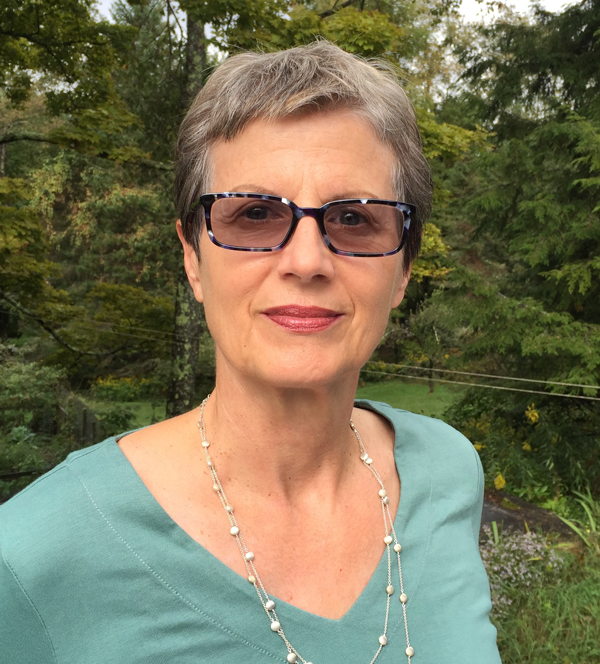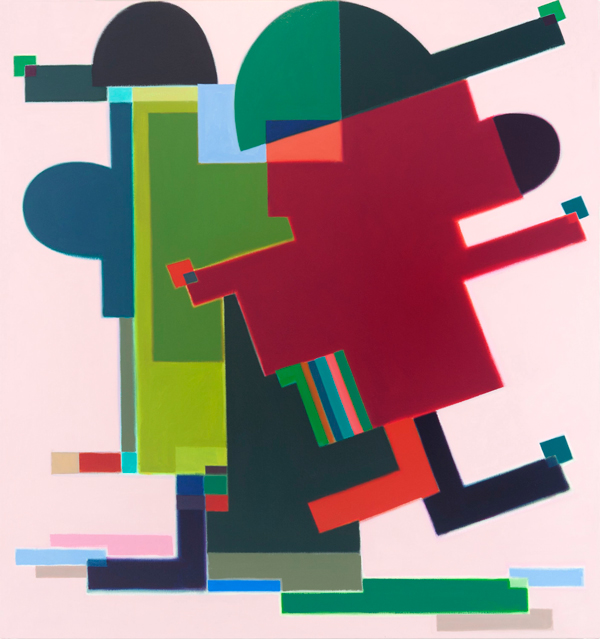If you are familiar with Laurie Fendrich’s work, you know that the artist is a New York–based painter of vibrant geometric abstractions that strike a precarious balance between order and subterfuge. And you may have heard about her 2016 John Simon Guggenheim Memorial Foundation Fellowship. But do you know that she is also a writer and teacher who embraces English novelist Jane Austen as a kindred spirit, advocates for painting in probing essays, teaches students to paint the old-fashioned way and dishes out heretical ideas in seminars called “Thinking about Art”?
Compressing all that in a brief profile is a challenge, but she helps by dismissing most of her early years. “I don’t have an interesting family story,” says Fendrich, 68, who was born in Paterson, New Jersey. “It’s just a plain old American background. In the rise of identity politics, I have nothing to offer.”

Laurie Fendrich
Even so, her evolution was not all that predictable. As a young artist surrounded by “American stuff,” she devoured well-drawn comic strips and developed a strong affinity for Stuart Davis’ painting. But what about Austen, who used words, not images, to detail the tightly regulated lives of her country’s landed gentry more than a century before Fendrich was born?
“When I was young, I got very sick and a teacher gave me a collection of Jane Austen’s novels,” she explains in a telephone interview. “That sort of changed my life. I may not have understood the novels, but I loved them. It’s the form, the way she is in such control of the plot, and the people who have such passion.”
Beyond their fine craftsmanship and comic edge, Fendrich’s spirited abstractions and Austen’s captivating stories may appear to have little in common. But as critic Mark W. Stevens has noted, Austen is a touchstone for Fendrich, who draws strength from the novels and titles some of her paintings after them. Although the connections are largely unnoticed, both the books and the artworks are the creations of women who work in circumscribed territory—Austen as a keen observer of human behavior at a particular time and place, Fendrich as a deft orchestrator of flat, interlocking, richly colored, soft-edged shapes. Both bodies of work are relatively modest in size and ambition, but intricately fashioned and extraordinarily complex. Things come apart but then fall into place.

A Motley Crew, 2016, oil on canvas, 36 x 34 inches, ©Laurie Fendrich, courtesy of Louis Stern Fine Arts.
In her youth, Fendrich could not have imagined that Austen would have a profound influence on her life’s work, or even what that work would be. As a student at Mount Holyoke College in South Hadley, Massachusetts, where she earned a BA in 1970, she studied painting but—mainly as a practical matter—majored in political science and gravitated to political philosophy with the goal of becoming a scholar. A few years later, when she came to terms with the fact that her true passion was painting, she entered the School of the Art Institute of Chicago, where she received her MFA in 1978.
Married to art critic and painter Peter Plagens since 1981, Fendrich has pursued parallel careers as an artist and teacher. From 1989 to 2014 her academic home was Hofstra University in Hempstead on Long Island. But she dreamed up the first of many “Thinking about Art” seminars in the early 1980s, while teaching at Art Center College of Design in Pasadena.
Drawing from her undergraduate background in philosophy, Fendrich assigned her students to read the writings of great thinkers such as Plato, Aristotle and, especially, Jean-Jacques Rousseau, who contended that civilization in general and the arts in particular tend to corrupt human morals and goodness. “That’s what wakes up students the most,” she says of Rousseau’s attack on the arts. “They don’t like it at first, but they are really intrigued. The students are astonished that anyone would argue that the arts are bad for society. But the arguments are so powerful that they fumble to defend themselves.” And that’s the point.

7, 2016, Conté crayon on Arches, 24 x 18 inches. ©Laurie Fendrich, courtesy of Louis Stern Fine Arts.
Of her Hofstra painting classes, Fendrich says: “The largest and most important goal is for my students to go away with an understanding that painting is a really beautiful and critically important part of culture. Not in an art-historical sense—I show images of works by great painters, alive today and from the past, but the overarching thing is that I love painting and I teach from that. It’s not a gooey thing; I teach the basics and proudly.”
All too aware that she is out of sync with a pedagogical shift that favors critical thinking over technical expertise, Fendrich tells students that they are going to learn such things as how to hold a brush and lay out a palette. “After you go away, your job is to do what you want—break the rules, bend them, whatever,” she says. “But you need something to start with and we will start with these rules.” In her opinion, “people who violate that are doing a disservice to students.”
Fendrich’s essays, a relatively recent pursuit, grew from a lecture presented at Hofstra in 1997 and revised for publication in the Chronicle of Higher Education in 1999 under the title “Why Painting Still Matters.” Focusing on abstract painting, she made a case for it as “an ineffable balance of sensation, experience and knowledge. In the midst of a world in which everything we see is morphing into something else, abstract painting is one of the few things left that allows us to see the possibility of something remaining constant.”
Although her subjects vary from French painter Henri Matisse to American critic Dave Hickey, Fendrich views her essays collectively as “a polemic to defend painting against hostile forces. They are wagon-circling pieces,” she says. “I have either written about painting or people who paint with an attitude that painting is the highest art form, the queen of the art forms. I am fully aware of the contemporary art world, but it doesn’t change the fact that the other arts need painting to be considered art. Painting doesn’t need them. But without painting, the other arts glide and shift into real life.”
“Laurie Fendrich” at Louis Stern Fine Arts in Beverly Hills, through December 3, 2016.


